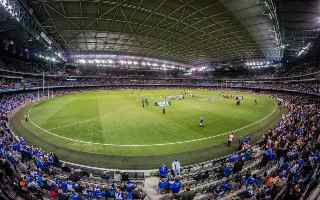Melbourne Cricket Ground (MCG)
| Capacity | 100 024 |
|---|---|
| 95,024 (Seats) | |
| Country | Australia |
| City | Melbourne |
| Clubs | - |
| Inauguration | 1853 |
| Renovations | 1861, 1876, 1881, 1884, 1897, 1900, 1904, 1906, 1912, 1927, 1937, 1956, 1967–1968, 1984, 1992, 1994, 2003–2005, 2011–2013 |
| Cost | A$ 150 million (1992), A$ 400 million (2005) |
| Record attendance | 121,696 (Collingwood - Carlton, 1970) |
| Address | Brunton Ave, Richmond VIC 3002, Melbourne, Australia |
Advertisement
Melbourne Cricket Ground – stadium description
The grounds east of Yarra River were used for sports from early 19th century, but the first building was erected here in 1854. It was humble wooden players’ pavilion that’s considered the beginning of Melbourne Cricket Ground, world’s largest cricket stadium and spiritual home to Australian rules football.
Very first grandstand was opened in 1861. The wooden structure could seat 6,000 people and was opened around the time MCG received its first oval field (previously hexagonal). First grandstand made with bricks was built in 1881.
In 1900 electric lighting was introduced. It proved well ahead of its time as attempts to play games under floodlights proved compromising. It was one of the first stadium to have telephone installed (1881) and a scoreboard (1882).
After a serious of redevelopments in early 20th century nearly all sections were rebuilt and expanded to hold 20,000 people (1912). Later changes weren’t that frequent, but their scale was greater. New grandstands were opened in 1927, 1937 and 1956. The latter redevelopment brought the Olympic Stand, which was built specifically before the 1956 Olympics that also saw a running track laid.
Key events from today’s perspective began in 1988, when concrete in the southern part of stands was found to be in very poor condition. By 1992 a massive new grandstand of four tiers was erected on a semi-circular blueprint. Its amazing scale earned it the name of Great Southern Stand. Espected to cost $100 million, it proved 50% more expensive, though.
Similar maneuver was done in 2003-2005 on the northern side. Single grandstands in this erea were demolished and replaced by an even larger semi-circular stand. This time total cost went over the $400m mark, but it also allowed capacity to officially exceed 100,000. However, crowds of that size and greater weren’t unseen since late 1950s.
MCG’s history is of course primarily that of Australian cricket, to which it is home. But also Australian rules football (AFL) settled here very soon (first game in 1859), earning the place a “spiritual home” status. Over various periods of time up to 10 teams (!) were playing both disciplines every year. No wonder that beside large cricket events (2 World Cups held here) it’s also the home to AFL final every year.
Other sports weren’t that prevalent in MCG’s history, but the stadium saw its first football (soccer) game at the same time of its first athletic event, in 1956. Since then athletics returned once, in 2006 (Commonwealth Games) and football is a more “frequent visitor”. Some of Australia’s prestigious games, friendly or qualifiers, were held here. Also, top European clubs occasionally use the stadium for their overseas tournées.
Interestingly, Melbourne Cricket Ground holds a major record since 1984. Six massive floodlight masts reach 85 meters each, being the tallest worldwide. While they seem proportional to the stadium’s grand scale, each mast is as tall as a 27-floor building.
Advertisement
Pictures
-

04.01.2009 © Blackwych (cc: by-nc-nd) 
13.11.2014 © evilDink 
17.10.2014 © Seb 
01.09.2013 © ajhaysom 
10.02.2013 © aa440 (cc: by-nc-nd) 
25.12.2013 © Simon Berendt 
01.03.2015 © Wintice C 
25.11.2013 © Fabien Bernard 
24.12.2014 © John Harrison 
13.07.2014 © globetrekimages 
14.01.2015 © Tourism Victoria (cc: by) 
04.02.2015 © eeemmmiii 
15.11.2014 © Helefran 
02.03.2014 © Clare Nolan 
12.11.2013 © Vanguard Visions (cc: by) 
17.11.2013 © Andrew Scanlon 
19.04.2015 © Ruud Bos 
01.08.2014 © Wajahat Mahmud 
28.09.2014 © globetrekimages 
16.01.2011 © Lokesh Dhakar (cc: by) 
16.01.2011 © Pranav Bhatt (cc: by-nc-sa) 
27.03.2014 © dimsum81 
28.03.2015 © Damian White 
28.03.2015 © Damian White 
28.03.2015 © Damian White 
22.08.2009 © Sascha Wenninger (cc: by-sa) 
27.07.2014 © Richard Woods 
28.12.2013 © Simon Yeo 
29.03.2015 © Damian White 
29.03.2015 © Rohit Bawa 
21.02.2015 © Blind ThirdEye 
11.07.2014 © globetrekimages 
14.02.2015 © Tourism Victoria (cc: by) 
14.02.2015 © Tourism Victoria (cc: by) 
14.02.2015 © Tourism Victoria (cc: by) 
23.08.2014 © globetrekimages
Related news
2025
2023
2022
2016
-

USA: All-time record for the smaller football
On Saturday American football celebrated by far the largest crowd in history. Still far behind association football, the American branch seems to be the only one still growing in crowd size.
-

New section: Meet the world’s 20 biggest stadiums!
You’ve seen too many rankings like this? No, you haven’t, or so says your survey feedback. We decided to step up and present a permanent list of the largest football stadiums around the world!
-

Australia: What’s the stadium future for Melbourne?
There are two visions and they’re mutually exclusive. One envisions a much improved Etihad Stadium, the other proposes to demolish it and build from scratch between MCG and AAMI Park.

 StadiumDB
StadiumDB


